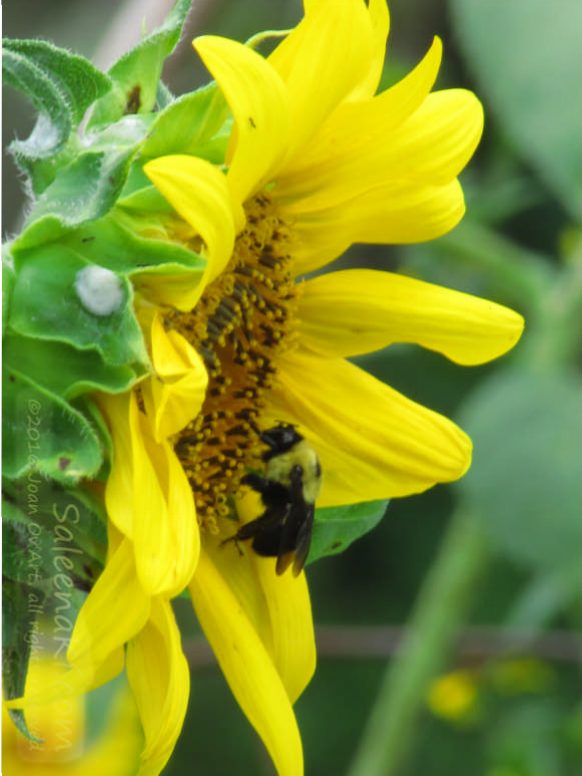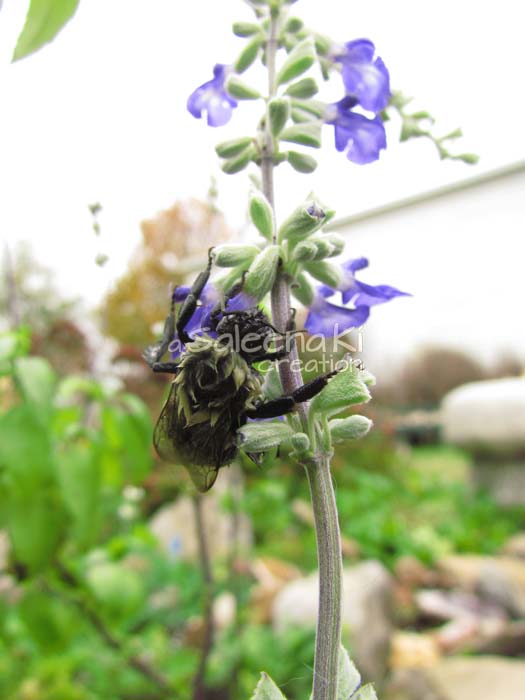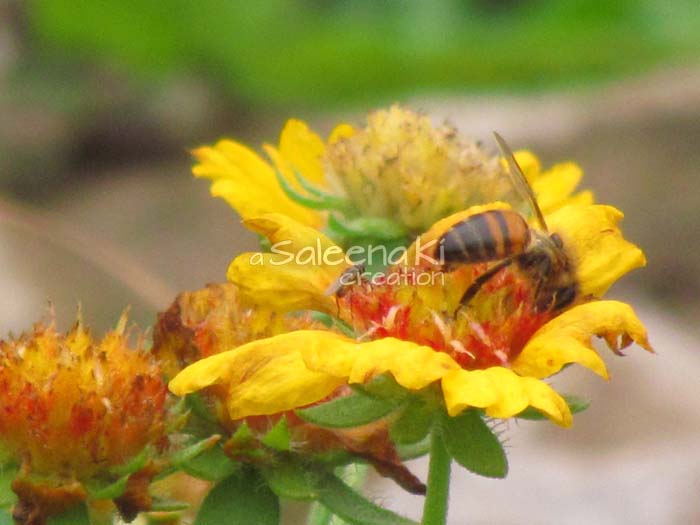
21 Apr Things to DO for Our BEES
Top photo is a Bumble Bee in a volunteer Bird planted Black Oil Sunflower
in the Happy Morning Sun Garden
Last week I bought some flowers from Lowes. One happened to be a Columbine, a nice pale yellow one. I also bought a pink one from Home Depot. I happily planted the pink one right in the heart of my Marys Garden. It looks so cute…perfect! Right? A few days later, I was tidying up the Greenhouse and picked up some tags that had been in the flowers I planted. Much to my dismay, tucked in behind the Columbine’s Tag was another tag with a beautiful flower on it and lightly said something like, This plant is protected from mites, (naming pests) etc, by the application of Neonicotinoids. As if they are doing something wonderful. I was horrified! I had planted a systemic toxic poison to our pollinators right in the heart of our Divine Feminine Garden!
I hadn’t seen it because it was tucked behind the tag. I ran to find the other light yellow one I hadn’t planted yet and there is was, the same tag, tucked in behind the flower tag. Then I got mad! Mad at myself that I had forgot my earlier research and caution. Read this post to understand the danger of Neonicotinoids:
BEE FRIENDLY HABITAT-PROTECT OUR POLLINATORS
Unbelievable that anyone would be stupid enough to use a toxic chemical that will kill the pollinators that will be attracted to them to nectar. Systemics are particularly terrible because they infuse the whole plant, leaf, flower and seed with the toxin and it last for several years if the plant is a perennial. It also washes into the soil, moving into neighboring plants to infect them.
I was so mad… tonight I took that yellow plant back to Lowes and asked them to send my complaint to whoever orders plants… Last year there were rumors that Lowes and WalMart were going to stop selling plants with Neonicotinoids. They haven’t yet.
I should have dug up the pink one, too. It was raining and I was in a hurry to get to town… Now it is late and raining more, so now I am sitting here feeling sad thinking about what it is doing to my Garden and what it might do to my Pollinators. This was a wakeup call to me, a steward of a Pollinator Habitat.
So on the UP Side, there are things you can DO to help our POLLINATORS. I found an article that list 6 ways you can help them:

Bumble Bee on a “HomeGrown from Seed” Blue Salvia
in the Blue Fairy Garden
1. Grow native flowering plants around your home.
Flowering plants, which supply both pollen and nectar, are critical to pollination of crops by honeybees.
Landscaping with flowering plants “is the healthiest thing you can do for local bee populations. Everyone can do it, even if you just have an apartment patio,” says conservationist Terra Wellington, author of “The Mom’s Guide to Growing Your Family Green.”
Put more emphasis on creating honeybee habitats and less emphasis on producing perfectly manicured gardens, she says.
“It’s fine if you want some lawn space, but for the rest consider a more natural look with native plants,” Wellington says. “It will look more interesting and varied, and cut down on your maintenance time.”
If possible, the plants should bloom at various times — some in the spring, others in the summer and some in the fall.
“If everything in your garden only blooms in the spring, pollinators have to look somewhere else for food the rest of the growing season,” Wellington says.
For advice on the types of flowering plants that are ideal for where you live, check out this guide from the Pollinator Partnership.
Honey Bee in Rusty’s Calendula
in Butterfly Heaven-Haven Garden
2. Reduce or eliminate the use of pesticides at home.
Generally speaking, traditional pesticides pose a threat to honeybees. In particular, you should avoid neonicotinoid products, which have been linked to a phenomenon known as Colony Collapse Disorderinvolving the disappearance of a majority of a colony’s worker bees. The Xerces Society, an insect conservation group, says residue from neonicotinoid pesticides can be lethal to bees, butterflies and other flower-visiting insects.
To sign a petition calling for a ban on neonicotinoid pesticides, visit this page.
3. Provide water for bees.
Especially in the summer, bees need water, says urban beekeeper Nicole Buergers, founder of the Bee2Bee Honey Collective. So why not set up your own water station for bees?
“Consider a ‘bee bath’ with shallow water and a textured surface — think a bird bath with rocks or marbles,” Buergers says. “Make sure the water source is replenished regularly so bees can count on it.”
4. Get familiar with your local beekeepers.
“Know the source of your honey and where the hives are located,” Buergers says.
The label on any locally produced honey should indicate whether it’s raw, and should list the beekeeper’s address, phone number and website, she says. Be sure to inquire about whether the beekeeper has adopted sustainable beekeeping practices, Buergers says.
5. Buy organic food.
Organic farming boosts the health of honeybees by decreasing exposure to toxic chemicals and protecting native habitats, according to the Organic Trade Association.
“One of the simplest ways to conserve our pollinator populations in an agriculturally reliant world is through organic farming. Consumers can rest assured that every time they purchase an organic product, they are supporting pollinator health,” says Jessica Shade, director of science programs for The Organic Center, a nonprofit that conducts research about organic food and organic farming.
6. Support companies that support bees.
An array of businesses have embraced saving our honeybee population. Here are three examples:
- Beepods is donating a portion of each sale of its organic Bee Better Butter balms and salves to a Pollinator Partnership program that promotes pollination by encouraging students to plant gardens.
- Ice cream brand Häagen-Daz has installed one of the largest, privately funded pollinator habitats on 840 acres of farmland maintained by its almond supplier in California. The bee-friendly habitat consists of 6½ miles of hedgerow and 11,000 native drought-tolerant shrubs and flowering plants.
- MediNatura, a manufacturer of prescription and over-the-counter pharmaceuticals made from natural medicines, is matching consumers’ donations of at least $30 to the nonprofit Heifer International for a project that provides beekeeping equipment and training for farmers in developing countries. The company says it’ll donate up to $15,000 through July 15, 2018.
Read the Full Article:

